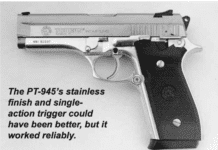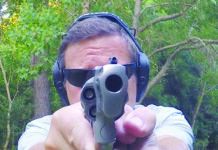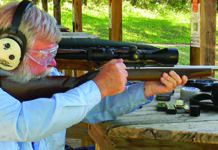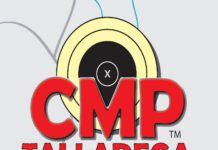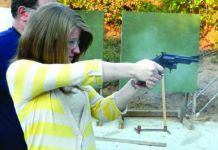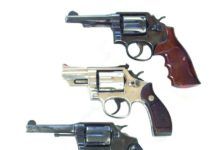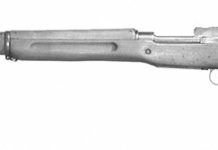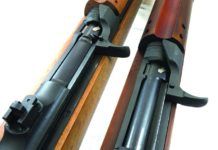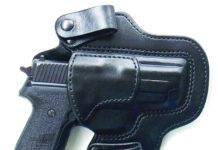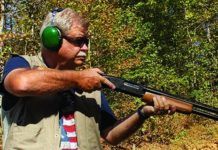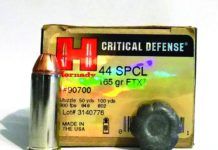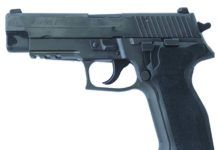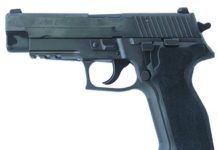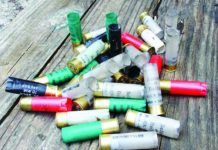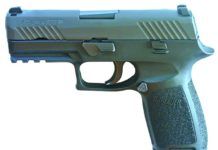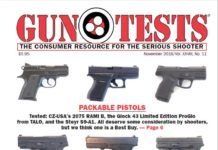357 Magnum Personal Defense Loads: Black Hills Is a Best Buy
When it comes to the 357 Magnum cartridge, the consensus is the round is a great performer. The cartridge has taken deer, bears, and even larger game. However, the rub is that these exploits were made with larger revolvers, often with barrels of at least 6 inches. When it comes to personal defense, most folks are going to carry a 2-, 3-, or 4-inch-barrel revolver. So, for those shooters who prefer the wheelgun, the Magnum needs to work in a shorter barrel.
The slow-burning powder used in Magnum loads is often a canister grade of Winchester 296 or Hodgdon H 110. This powder develops its power and velocity from a slower burn. Purpose-designed defense loads must use relatively faster-burning powder, usually a powder in the middle range. Another problem with accuracy and consistent performance is bullet pull. The lighter bullets used in defense loads often do not show as consistent a powder burn as heavier bullets, and this limits velocity with 100- to 110-grain bullets. However, makers such as Cor-Bon seem to have perfected a loading process that has solved many of the problems with bullet pull and have even gotten a consistent powder burn in short barrels. More pertinent in recent years, the Magnum has been downloaded. In present form, SAAMI specs restrict 357 Magnum pressure levels to about the same as 9mm +P+ loads.
When you consider the flash, blast, and recoil inherent in the Magnum cartridge, the question must be asked: Is the 357 Magnum the best choice for personal defense over other revolver cartridges? We believe it is. The Magnum offers excellent performance in a relatively compact package that the big-bore revolvers cannot match for speed and packing ability. The Magnum is superior to the 38 Special, no matter how hot the Special is loaded. In the May 2012 issue, we looked at the 357 Magnum for animal defense and also have looked at the 9mm versus the 357 Magnum. In this report, we are looking at the 357 Magnum solely as a personal-defense cartridge and letting the Magnum stand on its own.
There are several concerns in choosing the 357 Magnum for personal defense. One of our raters has a great deal of police experience. He noted that the 22 LR, as an example, was a proven, though under-regarded, self-defense round when fired from a rifle largely because of the ease with which accuracy was obtained. From a pistol, the results are often dismal, so the shorter-barrel, lighter revolvers might also produce poor results. Another concern is muzzle blast. The concussion inside a home could be severe, the muzzle blast is tremendous in dim light, and sometimes the flash causes night blindness. The Magnum might literally leave you deaf and dumb. However, some modern loads are especially treated to create only light muzzle flash, and as a result, they are much better suited to personal defense. If you choose a heavy hunting load and fire it in a 4-inch barrel, you will probably experience excess muzzle blast. If you use the 110-grain Cor-Bon personal-defense load, you will not experience this excess muzzle blast. The Buffalo Bore 125-grain Tactical load is another excellent choice, carefully tailored to personal defense.
Used 38 Sp. Revolver Contest: Colt, Smith & Wesson, Ruger
Revolvers make excellent home-defense handguns. They are simple to use and reliable and will come up shooting after long periods of storage. There are no springs compressed when the revolver is loaded, and no magazines to keep up with. The revolver may be chambered for powerful and efficient cartridges, such as the 38 Special +P and the 357 Magnum. For shooters able to engage in only minimal training, the revolver makes a lot of sense. Conversely, many very experienced shooters trust the revolver and little else. The smooth-rolling double-action trigger helps avoid flinch and the rhythm, once learned, allows excellent hit probability.
We set out to find four used revolvers for this Bargain Hunter segment. They had to be high quality and chambered for either the 38 Special or 357 Magnum cartridge, with the emphasis on 38 Special. While most homeowners will load these revolvers with 38 Special ammunition, the 357 Magnum is certainly a viable option, so we tested the revolvers chambered for the Magnum cartridge with these heavy loads as well. Because we were looking for bargains, we limited the used cost to a maximum of $500 counter price. We found one revolver at that maximum and three for considerably less, including two revolvers at $300. We chose medium-frame revolvers for two of the handguns and small frames for the other two handguns.
Three were six-shot revolvers and one was a five-shooter. We elected not to pursue heavy-frame revolvers, such as the Smith & Wesson L frame or Ruger GP100, and we also did not look for J-frame type snubnose revolvers. Basically, we were looking for affordable houseguns that would do a credible job of home defense if called upon. The contenders were as follows
Trump’s Gun Agenda and Gun Tests’ Glossy New Look
Dear Mr. Woodard: First, let me compliment you on the continued publication of your fine magazine! Just read your editorial concerning the presidential election. I don't know how many people understand how clear the correlation between Ms. Clinton's vehement anti-2A views and her loss of what should have been a slam-dunk win. If the numbers are remotely correct, there are 80 million gun owners in America. This number presumes that most of those folks are adults and not felons; therefore, they were potential voters. Another stat says that roughly 1 out of 20 Americans have a concealed-carry permit.
Reproduction M1 Carbines: We Test Auto-Ordnance and Inland Manufacturing Models
The M1 Carbine was adopted during World War II, then proceeded to arm our soldiers during the Korean War and Vietnam War, making it one of the most widely produced of all U.S. Military rifles. Millions were produced, and at one time, surplus models were quite common and inexpensive. Try finding a vintage M1 Carbine today, and you will pay close to $1000 for a well-used specimen. Costs, however, will vary dramatically depending on which manufacturer produced the M1 Carbine, the model, features, and condition.
We opted to test two new M1 Carbine reproductions, the M1 1945 Carbine from Inland Mfg. (not the original Inland Mfg. but a new company) and the M1 Carbine Paratrooper from Auto-Ordnance (A-O).
We looked at these two Carbines for historical accuracy, for competition use in M1 Carbine Matches, and as a home-defense choice. In our opinion, the Inland is suitable for all three, where the A-O is not competition ready, but it satisfies the other two roles pretty well. Bottom line, our test team found these two carbines to be reliable, depending on the ammunition employed, offer good performance if the cartridge is used within its limits, and unlike some other M1 Carbines our testers have fired in the past, these two reproductions are accurate enough for nearly any use.
Inside-the-Waistband Holsters: We Like Barber Leather Works
In this review, we are looking at the holsters that readers asked us to test. Some are the exact holster suggested for review, others are a general type of holster we were asked to review and evaluate. It takes some time to collect and test these holsters, but we listen to readers. What we have is a mix of Kydex, leather, and composite inside-the-waistband holsters, or IWB, types, which many concealed-carry licensees prefer. We took a look at comfort, the balance of speed and retention, and value. While some are pricey, we also took a hard look at the least-expensive holsters of the same type. They ran the scale from A to D, with a number offering both affordability and practical value.
There are two basic types of IWB holsters, although some use a combination of the two traits. One uses the holster body, design, and molding to keep the pistol stabilized. The other uses compression from the body to keep the gun stabilized, much as if you simply stuck the gun in your waistline. With the former type, you might unbuckle the holster, but the gun is stabilized and the combination is held in the hand, which we prefer as a design. With others, the holster is floppy and cannot support the gun off the belt. Rating depended upon fit to the individual handgun, proper design and stitching, good attachment to the belt as an anchor during both carry and the draw, and the balance between speed and retention.
To rate an A, a proper inside-the-waistband holster should not collapse into itself after the handgun is drawn, and it should allow the user to place the handgun in the holster again without removing the holster.
Budget 20-Gauge Shoot Off: H&R, Century, and Mossberg
The shotgun can be an important part of the home-defense firearms collection. The scattergun offers excellent hit probability and provides a formidable option for those concerned with home invasions. The wisdom of such preparedness is reflected in the headlines every day. We live in a dangerous world. The problem is, many of us are on a budget and cannot afford a thousand-dollar tactical shotgun. Others are recoil shy or have a physical impairment that makes firing the mighty 12 gauge difficult. Even some who may be able to handle the 12 well will find the light and fast-handling 20 gauge has appeal.
In this installment, we test three affordable 20-gauge shotguns. The 20 gauge was chosen because, while generating about half the recoil of the 12 gauge, it has a little more than half the payload, which considering the ample power of the shotgun, seems to be a reasonable trade off. Even better for the tests, as it turns out the shotguns were choked Open, Modified and Full, giving us a unique opportunity to compare chokes and how they affect shot spread at home-defense ranges. After weeks of searching, we found three shotguns at or under $300. These included the Century International Arms JW-2000 double-barrel coach gun, a Mossberg 20-gauge pump, and an H&R Pardner single shot. Some may scoff at the idea of even considering the single shot or double barrel for home defense, but we found that while they might not be ribeye, they aren't chopped liver if used properly.
The 44 Special: An Old Number Is Revitalized by Modern Loads
The 44 Special is a misunderstood cartridge. Never meant to be a powerhouse, the 44 Special was introduced as a counterpoint to the 44-40 WCF and the 45 Colt. A continuation of Smith & Wesson's 44 Smith & Wesson Russian, the more powerful 44 Special was intended to be a mild-mannered and accurate big-bore cartridge. Loaded with a 246-grain round-nose lead bullet at about 800 fps, the Special is mild enough and accurate in good, tight revolvers. Experimentation by enthusiastic hand-loaders vastly improved the power of the cartridge, but those trials also wrecked quite a few revolvers in the process. Once the 44 Magnum revolver was introduced, the need for such heavy loads was eliminated, in our opinion.
That doesn't mean the 44 Special is dead. In fact, it retains its reputation as a shootable, accurate round, and it finds a home in many 44 Magnum cylinders as a training round. But what of wheelguns chambered just for the Special? Are there powerful-enough loads out there to make it a backwoods-suitable carry gun? A recent test of several 44 Special loads suggests that the old round is rocking along quite well, thank you very much.
Some of the loads tested below are strong loads, probably best used in heavy-duty 44 Magnum revolvers. A 48-ounce Smith & Wesson Model 29 is docile when fired with the Cor-Bon 200-grain DPX load, as an example. Put the same load in the 36-ounce Model 21 Smith & Wesson, and recoil is on the upper end of what most users are able to tolerate. Further, in the Charter Arms Bulldog at 20 ounces, only lighter loads should be used. To assess the shooting-comfort range of various loads, our test guns this time included the Smith & Wesson Model 21-4 44 Special with a 4-inch barrel and the Charter Arms Bulldog with 2.5-inch barrel. This offered a mix of size, weight, and barrel length. We feel that it would have been pointless to fire these loads in a 44 Magnum revolver with a heavy barrel underlug and target grips and declare them controllable. The practical field and carry revolvers used in the test provide a thorough outlook on ammunition selection.
A Better Price on SIG P226 CPO
Just got my December issue, and the first thing I noticed was the Guns of the Year choice of the SIG Sauer P226R as the "Best in Class Pistol." Had to snicker. I got mine at Bud's Gun Shop in Lexington, Kentucky. And it was as good as yours. When I first looked at it, I did the field strip, and it looked brand new. I am not an expert on SIGs, but I carried a 226 in 9mm for many years. I was just happy to hear the same story on the Certified Pre-Owned model. The bit of a snicker I had was because I only gave $636 for mine, whereas you paid $725. I also bought a 357 SIG barrel for it, and I am happy to say it handles the 357 SIG as well as the 40 S&W you tested. Thanks for the great article.
2016 Guns & Gear Top Picks
Toward the end of each year, I survey the work R.K. Campbell, Roger Eckstine, Austin Miller, Robert Sadowski, David Tannahill, Tracey Taylor, John Taylor, Rafael Urista, and Ralph Winingham have done in Gun Tests, with an eye toward selecting guns, accessories, and ammunition the magazine's testers have endorsed. From these evaluations I pick the best from a full year's worth of tests and distill recommendations for readers, who often use them as shopping guides. These choices are a mixture of our original tests and other information I've compiled during the year. After we roll high-rated test products into long-term testing, I keep tabs on how those guns do, and if the firearms and accessories continue performing well, then I have confidence including them in this wrap-up.
Shotgun Shootout: Self-Loader, Pump, or Dual-Action Design?
When we decided to test three tactical shotguns suitable for home defense, rather than test three pumps or three self-loaders, we tested one of each, and one that could be either. The Benelli Nova Tactical Pump was our first type, followed by a semi-auto Mossberg 930 Tactical and TriStar's TEC-12, the latter of which can operate as a pump or semi-auto. If we were jumping into the sandbox at the moment, we think the Benelli M3 might be our choice, especially after firing the near clone of it, the TEC-12. However, the team thought the Benelli Nova pump had the simplest action to use well, and for us, its performance could not be faulted. The Mossberg 930 Tactical had its advantages as well, among them being it was the most comfortable shotgun to fire and use. We had our preference, as we describe below, but you may decide one of the others is better for you. To make that decision easier, our shooters went over the three guns with an eye toward finding flaws, and before we begin in earnest, we will say we found few problems, and that any of these three would do good duty for home defense.
We have had generally good luck with Benelli's Nova variations over the years. Way back in July 2007, we tested the field-grade Benelli Nova Pump 12 Gauge and gave it an "A-" for its overall performance, the feel and function of the synthetic stock and forearm, and its selection of choke tubes, which was impressive for this bargain-priced firearm. Then in the October 2013 issue, we tested a Benelli Super Nova Tactical No. 29155 12 Gauge. That gun earned an "A-" grade, losing out to a less expensive Stevens 320 that was every bit as good as the Super Nova and hundreds of dollars cheaper. Also, that Tactical Super Nova was the heaviest of those shotguns, which can be good or bad depending on the shooter and the load. But in that test, our shooters particularly liked the feel of the grooved polymer forearm and pistol grip. Downside: The out-of-the-box trigger pull of 8.75 pounds was too hefty for our tastes. Functionally, however, the Super Nova was fine. Those same likes carry over to a Benelli Nova H2O, which features a nickel-plated barrel, that we have not worked into a head-to-head against other corrosion-resistant units. Functionally, it has felt and operated like the other Novas we've tested, but the unit we've been shooting off and on (No. 20090, $669 MSRP) for a couple of years has open rifle sights (blade front and rear notch), which we don't like as well as the Ghost Ring sight on the Nova Tactical, and the price is a big step up from the plain black Benelli. At the time of this test, GanderMountain.com listed the H2O at $650, not including shipping and other charges such as FFL receiving fees. If you need the anti-corrosion features, you may be willing to pay the premium price for it, but for us, because of the price and the sights, we'd have to call the H2O a "B" in terms of value.
Bigger 9mms Handguns: SIG, Arsenal, and Beretta Go At It
As noted earlier in this issue, 9mm auto-loading pistols are among the most commonly purchased firearms in America for pleasure, competition, and defense. These guns are offered in many styles and price points, ranging from a few hundred to several thousands of dollars. While the handguns in this comparison are not top-end, highly customized pistols costing thousands of dollars, they are generally marketed as being well above average quality in fit, features, and capabilities.
In this comparison, we test five pistols, three of which were built by SIG Sauer, one by Beretta, and one newcomer from Arsenal. The SIGs tested are the classic P210, the P226 MK25 used by the U.S. Navy SEALS, and the relatively new P320. The Beretta tested is the recently updated M9A3. The fifth gun is the new Strike One from Arsenal.
For our evaluation, we used three different 9mm loads from three different manufacturers in two different weights and two different bullet styles. As always, the guns in question were shot by multiple testers (this time three men and three women) of different backgrounds.
We did our accuracy testing at Boyert Shooting Centers, an indoor range in Houston, and followed the standard accuracy protocol of collecting five 5-round groups at 25 yards from a rest for each pistol/ammunition combination. For this test, we also performed a speed drill. The speed drill involved starting from a low-ready position, shooting twice to the chest and once to the head of a silhouette paper target. This test was performed at 7 yards by one experienced tester with large hands. The speed test was performed after the familiarization shooting, but before the accuracy testing. The tester was given only one opportunity to perform the test. As these pistols are supposed to be superior to the average offering, our team expected above-average results and graded accordingly. Though all five pistols turned in good results and had their fans, the testing yielded one clear surprise winner.
Download the Full November 2016 Issue PDF
Based on correspondence with readers over the years, I've been told repeatedly that when a firearm comes up with a B or lower grade, it really doesn't matter what the grade is. The winning gun sets the pace for the test, so readers usually say, "Why would I buy what Gun Tests says is a second-ranked gun?" That logic is hard to refute. So, when you're at the gun counter and are trying to find a rifle, shotgun, or handgun you might like, it's helpful to know what to buy, of course. But sometimes a well-meaning retailer will offer a second choice if the store doesn't have your A-ranked model. That's when a periodic reminder of which firearms were "Not Our Picks" might come in handy.




